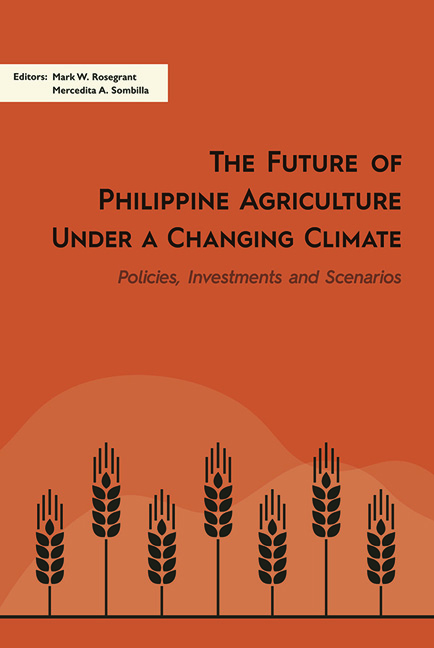Book contents
- Frontmatter
- Contents
- List of Tables
- List of Figures
- List of Appendices
- Preface
- Acknowledgements
- List of Contributors
- PART I Setting up the Scenarios: Current Status and Potential Impacts of Climate Change to Philippine Agriculture
- PART II Climate Change Adaptation Strategies and Sustainability of Philippine Agriculture
- PART III Investments and Supporting Policies to Alleviate Climate Change Impacts to Philippine Agriculture
- 9 A Biophysical Approach to Modelling Alternative Agricultural Futures under Climate Change
- 10 A Partial Equilibrium Approach to Modelling Alternative Agricultural Futures under Climate Change
- 11 A General Equilibrium Approach to Modelling Alternative Agricultural Futures under Climate Change
- PART IV Conclusion
- Index
11 - A General Equilibrium Approach to Modelling Alternative Agricultural Futures under Climate Change
from PART III - Investments and Supporting Policies to Alleviate Climate Change Impacts to Philippine Agriculture
Published online by Cambridge University Press: 29 May 2019
- Frontmatter
- Contents
- List of Tables
- List of Figures
- List of Appendices
- Preface
- Acknowledgements
- List of Contributors
- PART I Setting up the Scenarios: Current Status and Potential Impacts of Climate Change to Philippine Agriculture
- PART II Climate Change Adaptation Strategies and Sustainability of Philippine Agriculture
- PART III Investments and Supporting Policies to Alleviate Climate Change Impacts to Philippine Agriculture
- 9 A Biophysical Approach to Modelling Alternative Agricultural Futures under Climate Change
- 10 A Partial Equilibrium Approach to Modelling Alternative Agricultural Futures under Climate Change
- 11 A General Equilibrium Approach to Modelling Alternative Agricultural Futures under Climate Change
- PART IV Conclusion
- Index
Summary
High agricultural productivity is the key driver of successful structural transformation to promote long-term economic growth (see Chapter 1, this volume). Climate change, however, has the potential to impede the structural transformation process by introducing new and complex agricultural production risks at both national and global levels. Nationally — and especially in an already vulnerable archipelagic country like the Philippines — the adverse impacts of climate change could directly reduce agricultural productivity, while the indirect impact on global trade, and hence world food prices, could have negative impacts on the economy's international terms of trade. Both the direct and indirect effects of climate change could potentially damage the Philippine economy, as more resources are needed in the future to produce the same level of outputs.
Projections indicate that lower crop productivity induces the agricultural sector to retain less productive labour and capital, thereby absorbing resources that could be used more productively in the nonagricultural sectors and slowing the process of structural transformation. Higher world crop prices induced by climate change cause the country to pay more for imported food. On the other hand, the transmission of higher agricultural prices to domestic markets benefit farmers and rural households because they receive more income from agricultural activities. As incomes increase, farmers are motivated to invest in improving crop productivity and increasing production, which potentially helps mitigate the high word prices induced by global climate change. Estimating how these drivers interact in the economy is critical to determining their direct and indirect effects, and hence the net impact of climate change on the Philippine economy.
This chapter presents results of research designed to assess the impacts of climate change by considering both crop productivity and global agricultural trade effects that provide the main channels through which climate change directly affects the agricultural sector and indirectly affects the rest of the economy. An economywide computable general equilibrium (CGE) model was used to capture direct and indirect linkages, focusing on macroeconomic performance and the effects on long-term growth and structural change. The analysis also explores scenarios that include alternative policies intended to bring about the most advantageous outcomes in terms of higher economic growth and better income distribution.
- Type
- Chapter
- Information
- The Future of Philippine Agriculture under a Changing ClimatePolicies, Investments and Scenarios, pp. 492 - 534Publisher: ISEAS–Yusof Ishak InstitutePrint publication year: 2018



